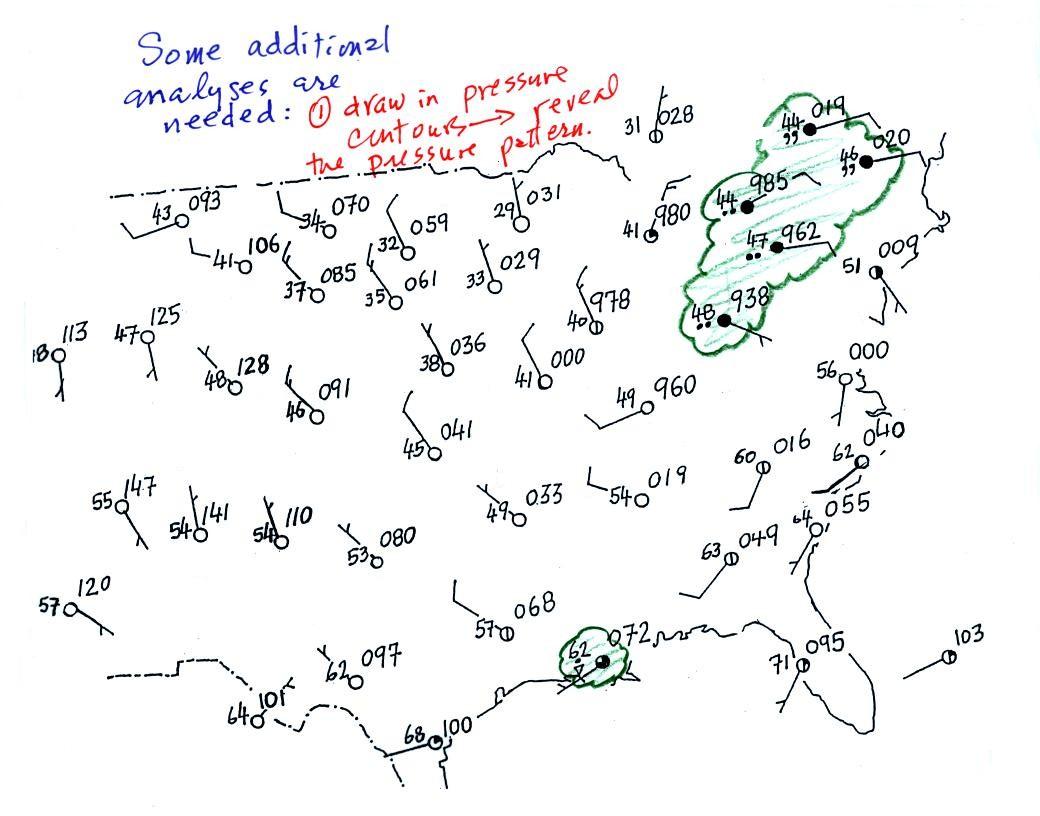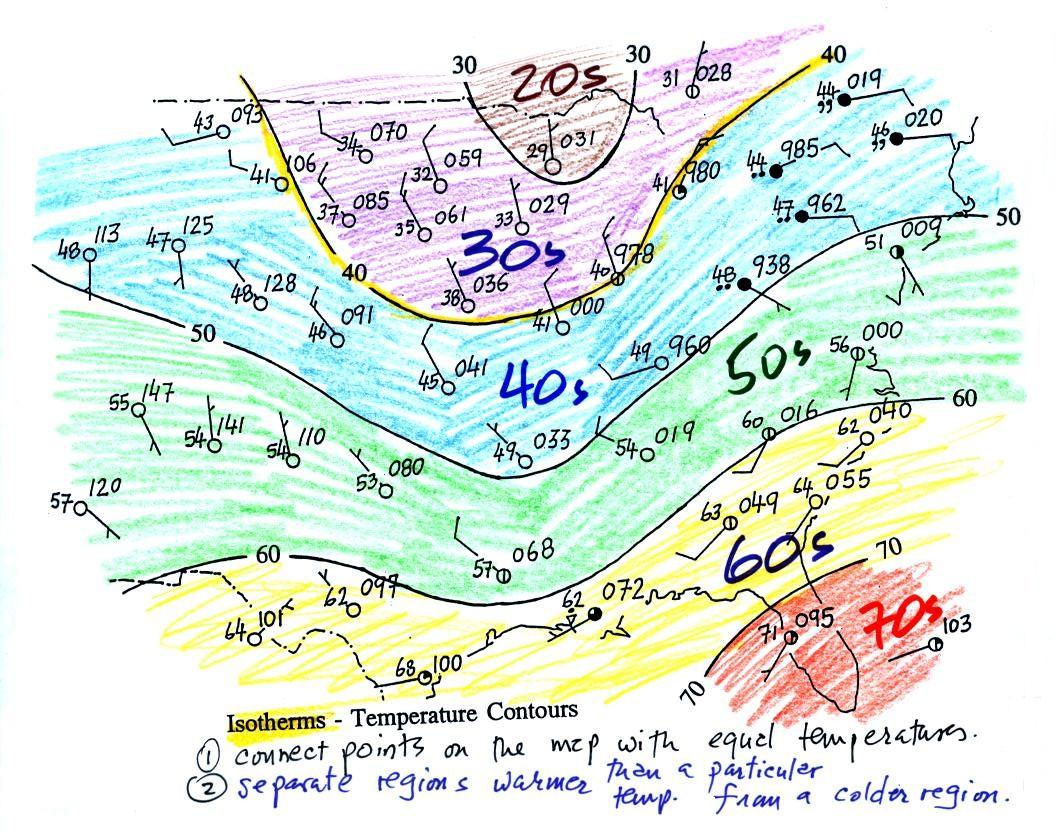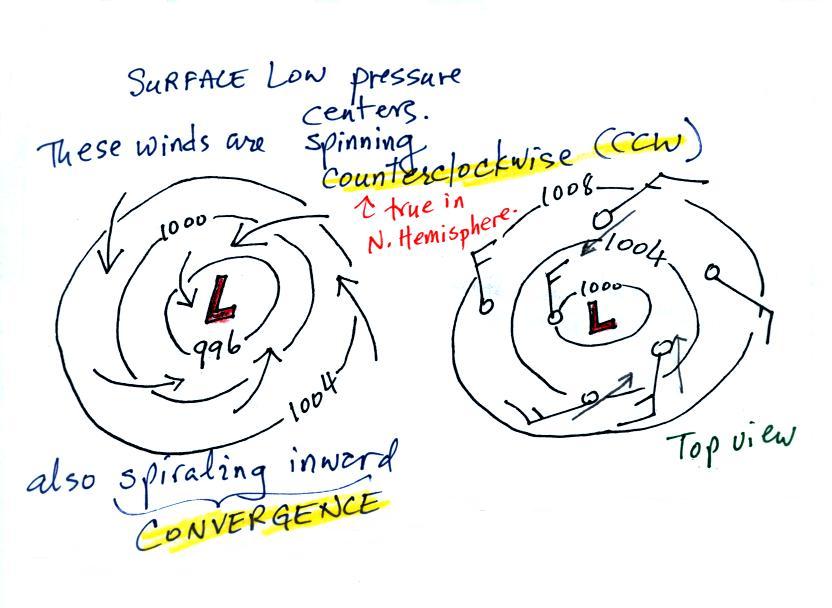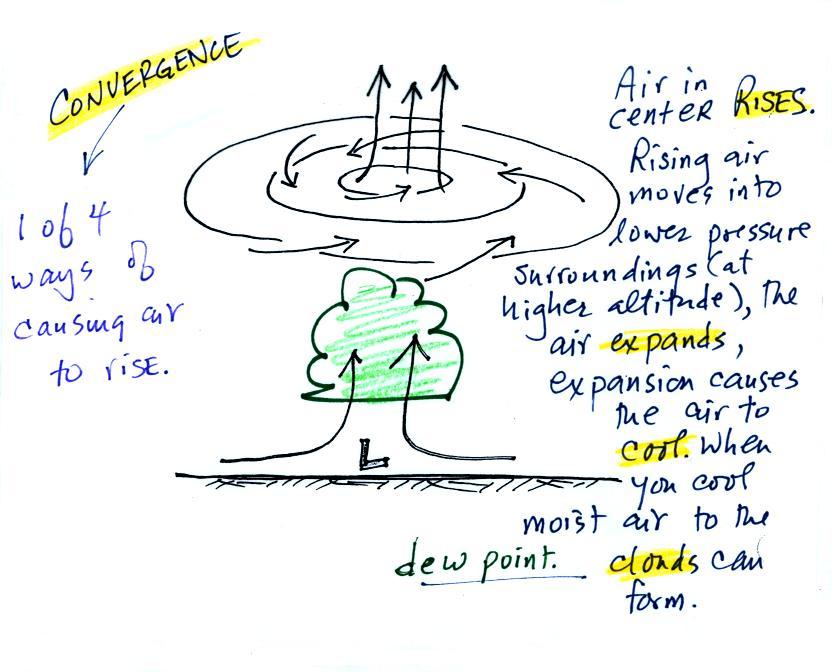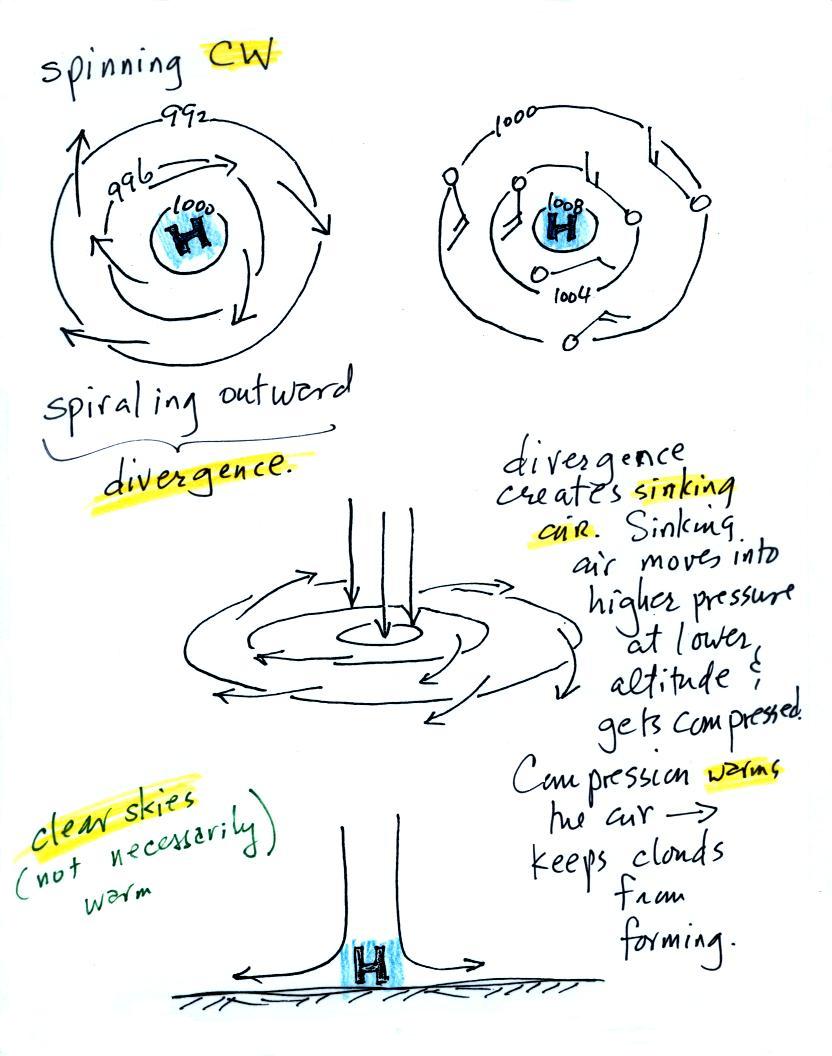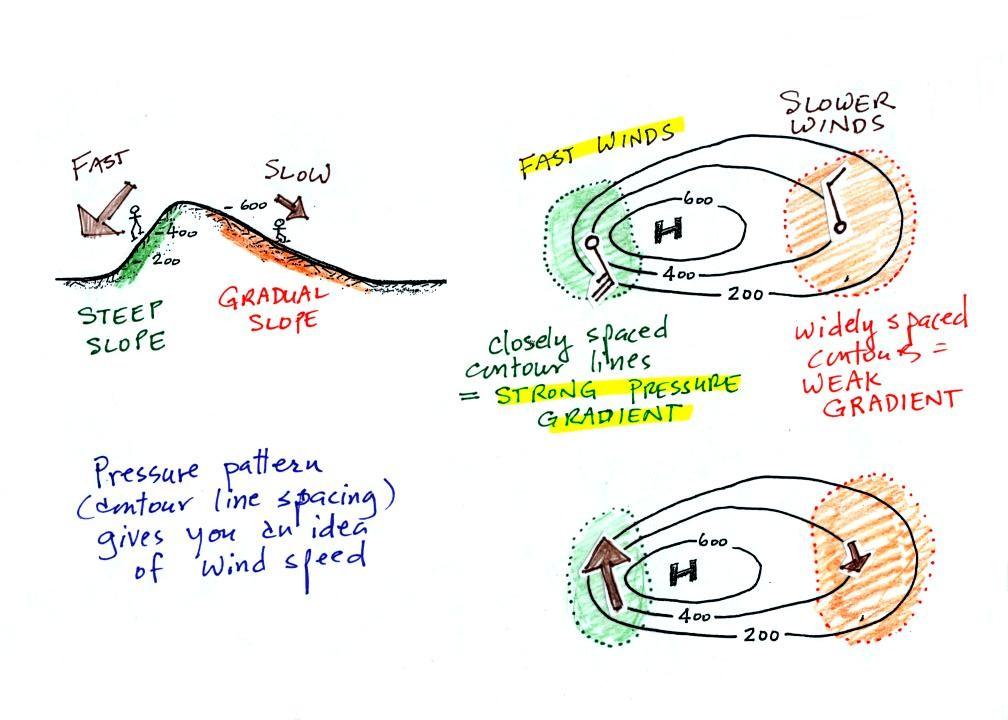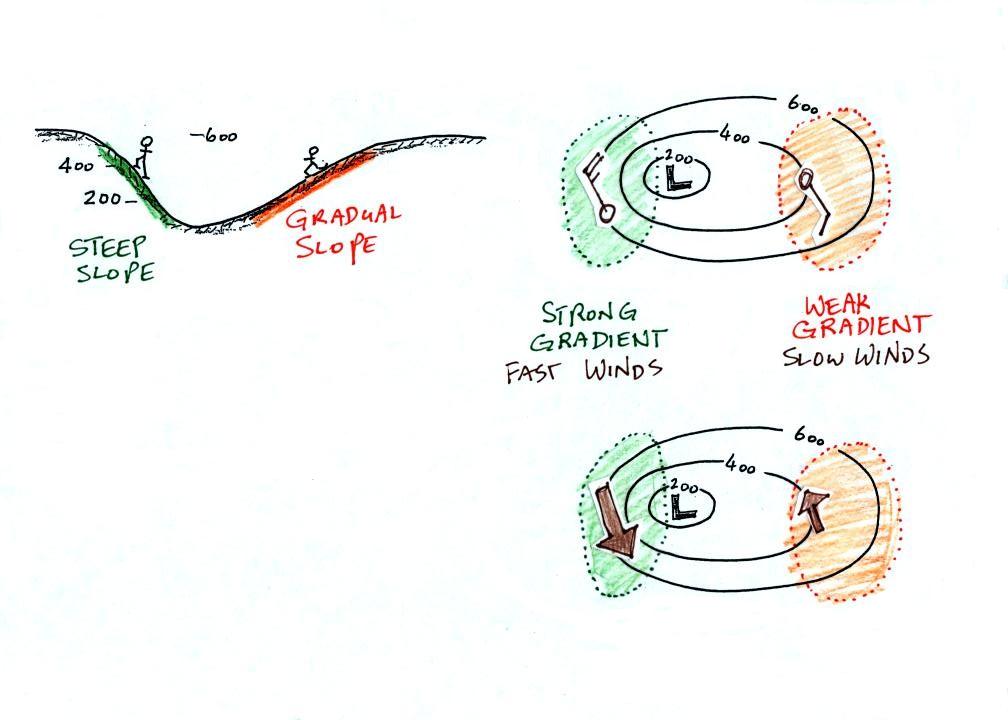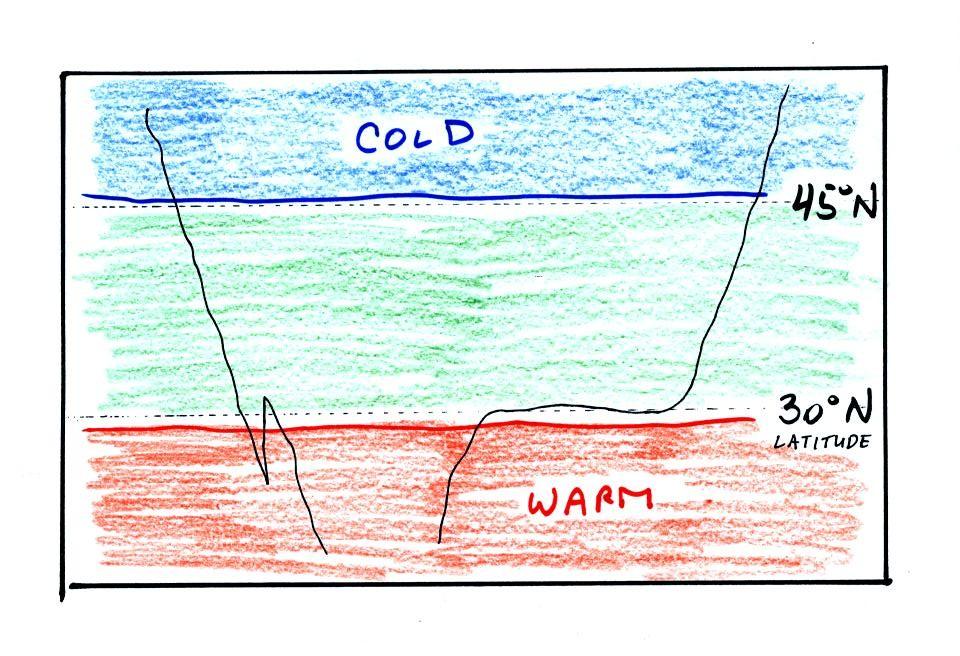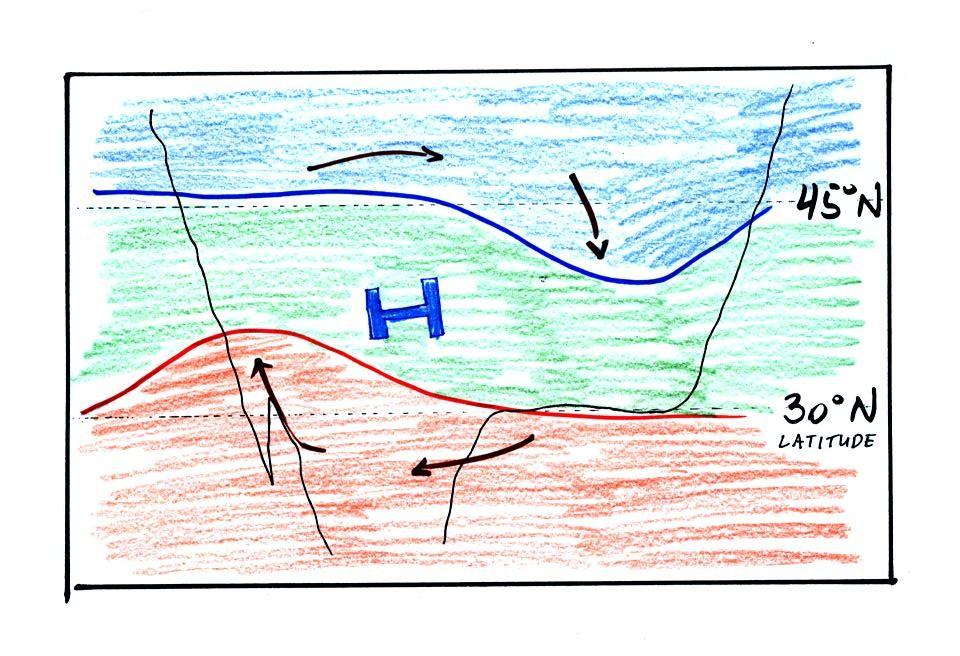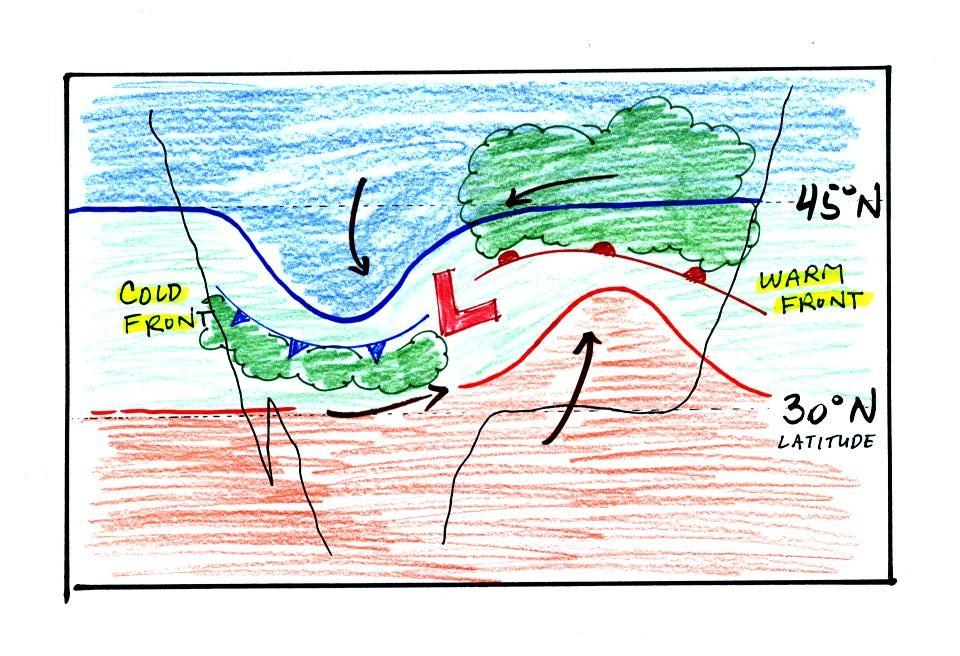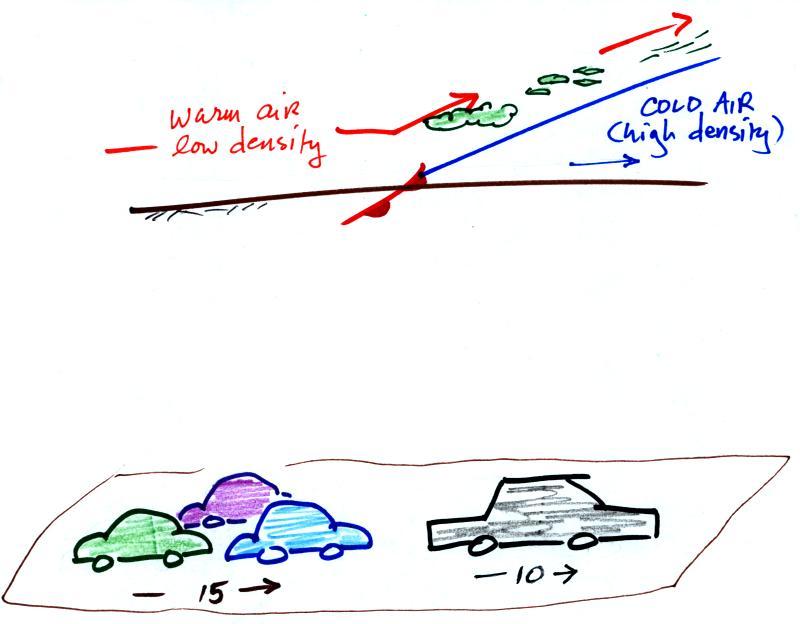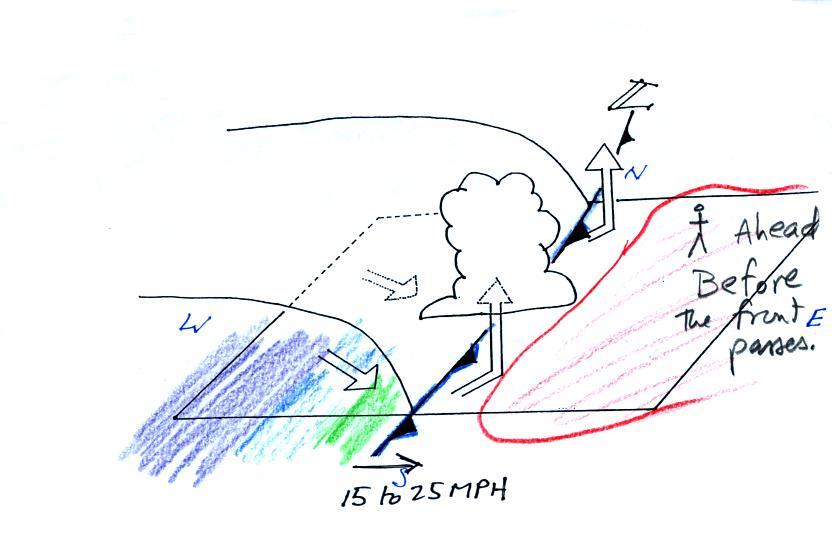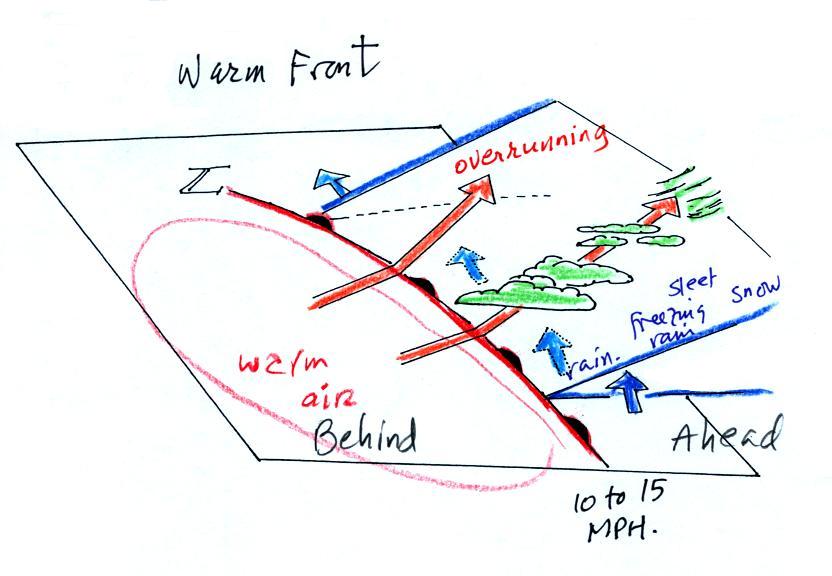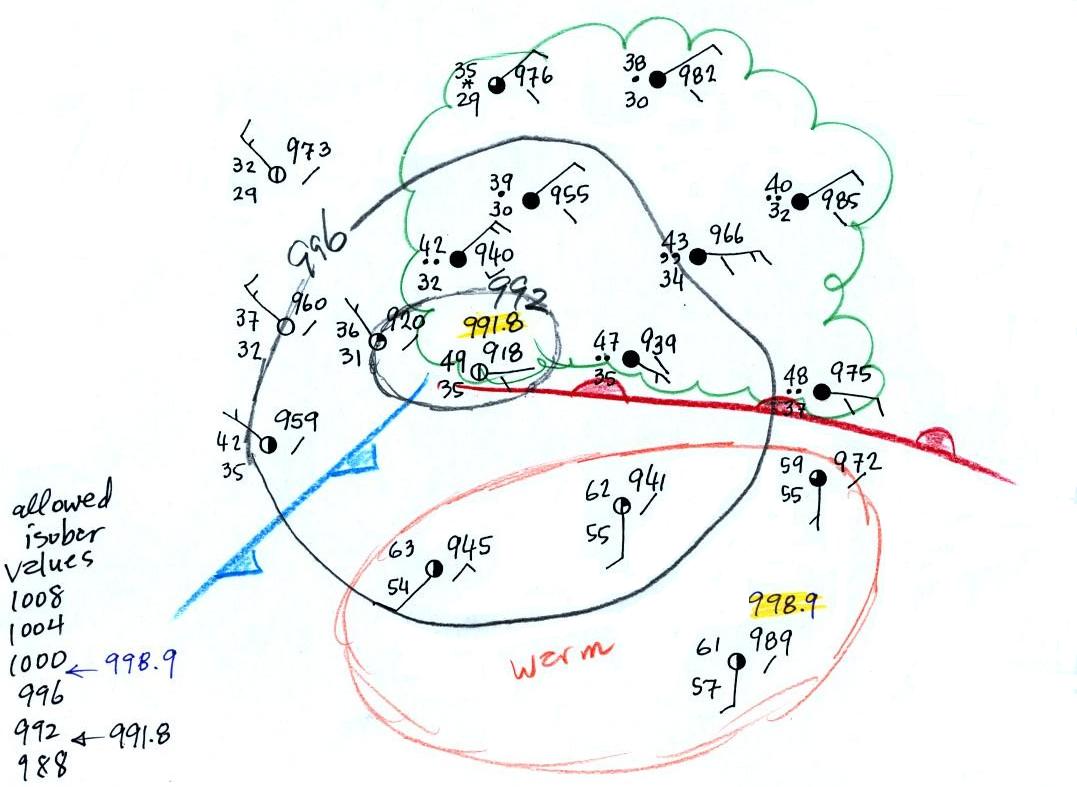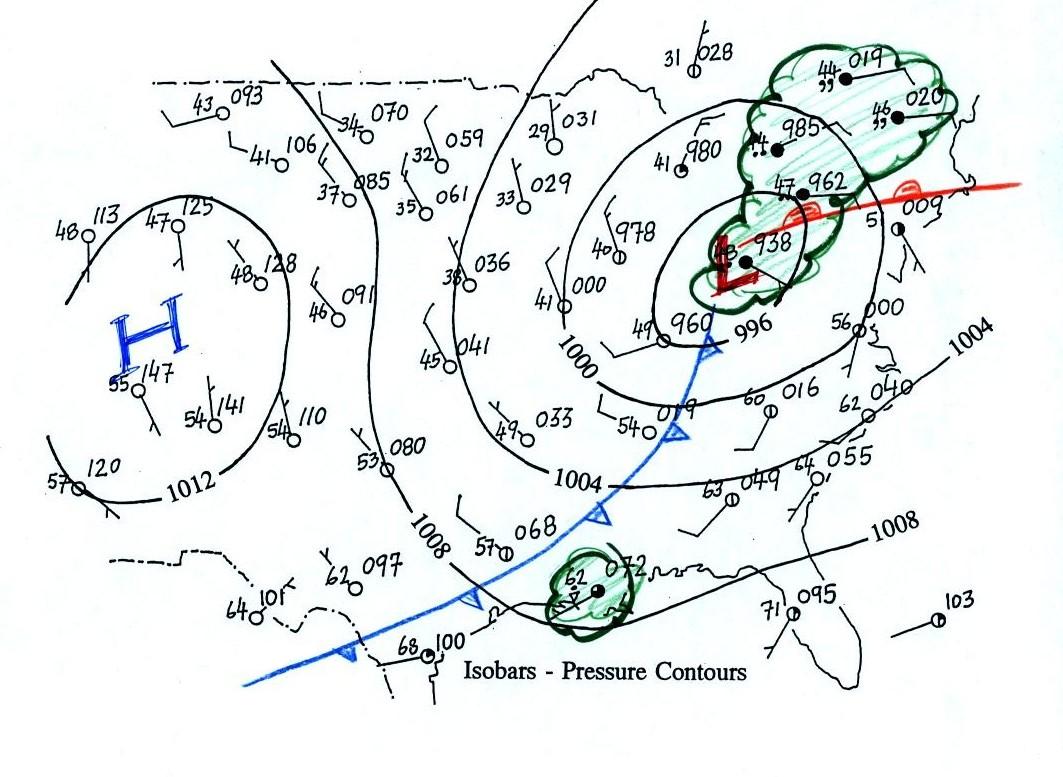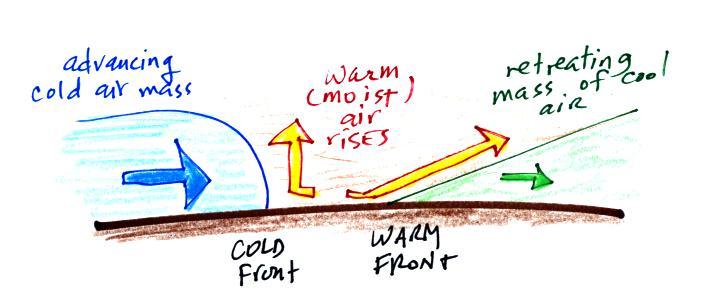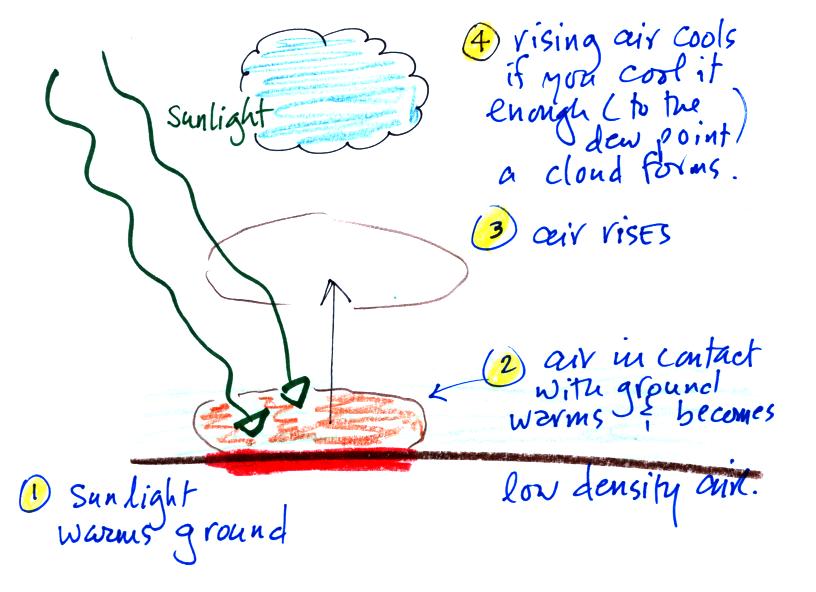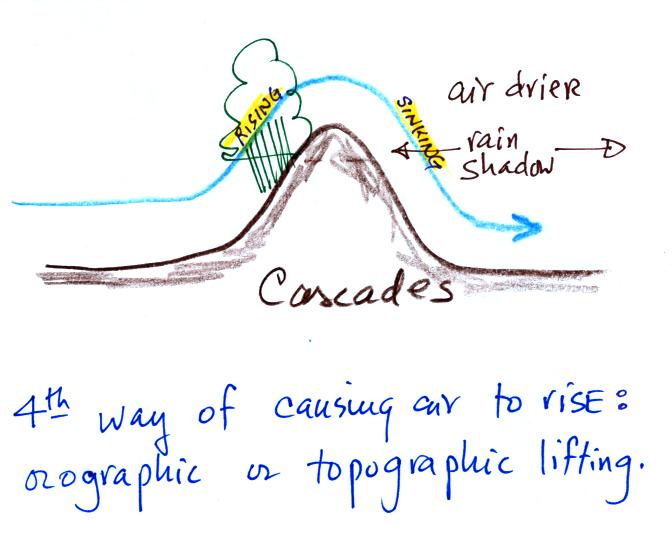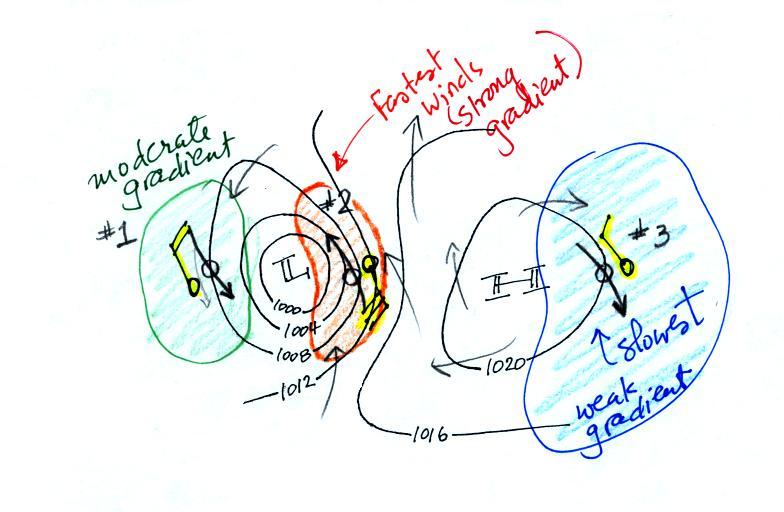Now that we have learned how
surface weather data are plotted on a map, we will look at some of the
analyses of the data that can be done.
Here's a relatively simple example of a surface map.
Pressure, wind, temperature, cloud cover, and weather data are
shown.
Plotting the surface weather
data
on a map is
just the
beginning. You really can't tell, for example, what is causing
the cloudy weather
with rain (the dot symbols) and drizzle (the comma symbols) in
the NE portion of the map above or the rain
shower along the Gulf Coast. Some additional
analysis is needed. A meteorologist would usually begin by
drawing some contour lines of pressure to map out the large scale
pressure pattern. We will look first at contour lines of
temperature, they are a little easier to understand (the plotted data
is easier to decode and temperature varies across the country in a
fairly
predictable way).
Isotherms, temperature
contour lines, are usually drawn at 10 F
intervals.
They do two things: (1) connect points on the map that all
have the same temperature, and (2) separate regions that are warmer
than a particular temperature from regions that are colder. The
40o F isotherm highlighted in yellow above passes through
a city which is reporting a temperature of exactly 40o.
Mostly
it
goes
between
pairs
of
cities:
one
with
a temperature warmer than 40o and the other
colder
than 40o. Temperatures
generally decrease with
increasing
latitude: warmest temperatures are usually in the south, colder
temperatures in the north.
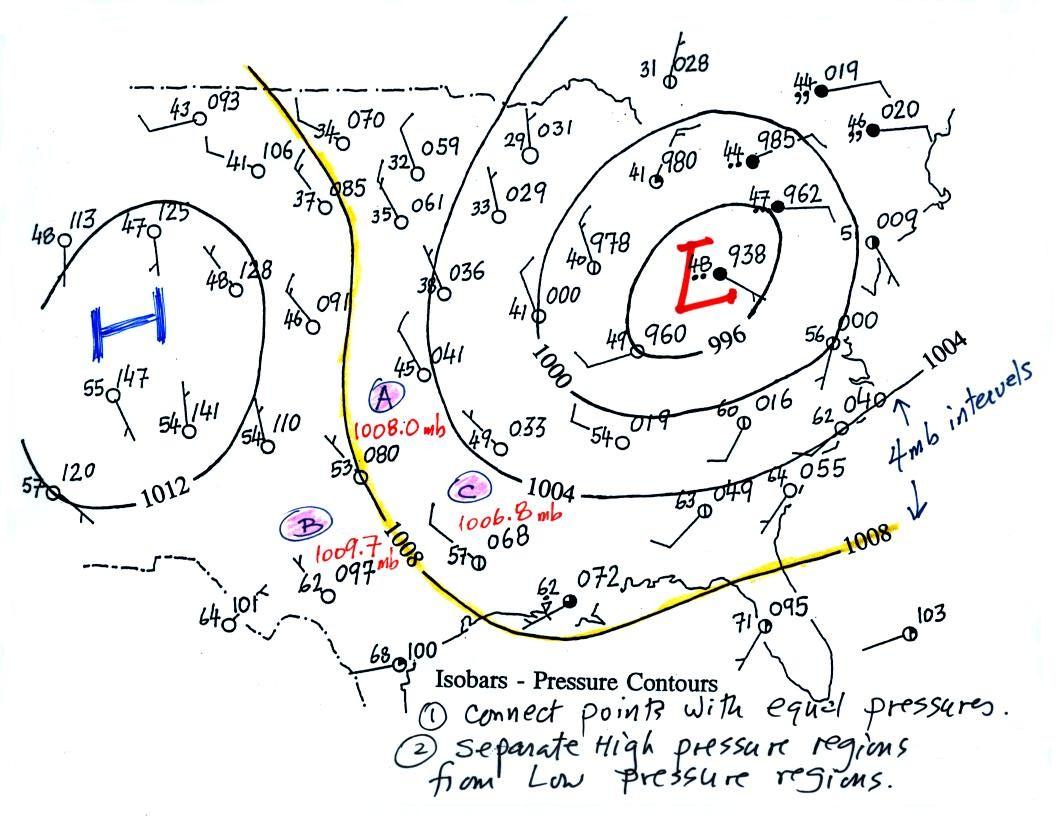
Now the same data with isobars
drawn in. Again they
separate
regions with pressure higher than a particular value from regions with
pressures lower than that value.
Isobars are generally drawn at 4 mb intervals. Isobars also connect points on the map
with the same pressure. The 1008 mb isobar (highlighted in
yellow) passes through a city at Point
A where the pressure is exactly
1008.0 mb. Most of the time the isobar
will pass between two
cities. The 1008 mb isobar passes between cities with
pressures
of 1009.7 mb at Point B and
1006.8 mb at Point C.
You would
expect to find 1008 mb somewhere in between
those two cites, that is where the 1008 mb isobar goes.
The pattern on this map is very different from the
pattern
of
isotherms. On this map the main features are the circular low and
high pressure centers.
Just locating closed centers of high and low pressure will already
tell you a lot about the weather that is occurring in their vicinity.
1.
We'll start with the large nearly circular centers of High and Low
pressure. Low pressure is drawn below.
Air will start moving
toward low
pressure (like a rock sitting on a hillside that starts to roll
downhill), then the Coriolis force will cause
the
wind to start to spin (we'll learn more about the Coriolis force later
in the semester). In the northern hemisphere winds spin in a
counterclockwise (CCW) direction
around surface
low pressure
centers. The winds also spiral inward toward the center of the
low, this is called convergence. [winds spin clockwise around low
pressure centers in the southern hemisphere but still spiral inward,
don't worry about the southern hemisphere until later in the course]
When the converging air reaches the
center of the low it starts to rise.
Rising air expands (because it is moving into lower pressure
surroundings at higher altitude), the expansion causes it to
cool. If the air is moist
and it is cooled enough (to or below the dew point temperature) clouds
will form and may then begin to rain or snow. Convergence is 1 of 4 ways of causing air
to rise. You often
see
cloudy skies and stormy weather associated with surface low pressure.
Surface high pressure
centers are pretty much just the opposite situation. Winds
spin
clockwise
(counterclockwise
in
the
southern
hemisphere)
and
spiral outward (in both hemispheres).
The
outward motion is called divergence.
Air sinks in the center of
surface high pressure to
replace the diverging air. The sinking air is compressed and
warms. This keeps clouds from forming so clear
skies are normally found with high pressure (clear skies but not
necessarily warm weather, strong surface high pressure often forms when
the air is very cold).
2.
The
pressure pattern will also tell you something about where you might
expect to find fast or slow winds. In this case we look for
regions where
the isobars are either closely spaced together or widely spaced.
Closely spaced contours means
pressure is changing
rapidly
with
distance. This is known as a strong pressure gradient and
produces fast winds. It is analogous to a steep slope on a
hillside. If you trip, you will roll rapidly down a steep
hillside, more slowly down a gradual slope.
The winds around a high pressure
center are shown above using both the
station model notation and arrows. The winds are spinning clockwise and
spiraling outward slightly. Note the different wind speeds (25
knots and 10 knots plotted using the station model notation)
Winds spin counterclockwise and
spiral inward around
low
pressure
centers. The fastest winds are again found where the pressure
gradient is strongest.
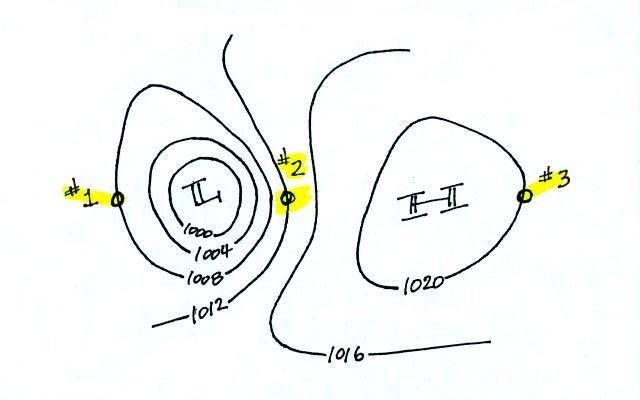
You should be able to
sketch in the direction of the wind at each of the three
points and determine where the fastest and slowest winds would be
found. (you'll find the answers at the end of this lecture)
3.
The
pressure pattern determines the wind direction and wind
speed. Once the winds start to blow they can affect and change
the temperature pattern. The figure below shows the
temperature pattern you would
expect to see if the wind wasn't blowing at all or if the wind was
blowing straight from west to east. The bands of different
temperature are aligned parallel to the lines of latitude.
Temperature changes from south to north but not from west to
east.
This isn't a very interesting
picture. It gets a
little
more interesting if you put centers of high or low pressure in the
middle.
The clockwise spinning winds
move warm air to
the north on
the western
side of the High. Cold air moves toward the south on the eastern
side of the High. The diverging winds also move the warm and cold
air away from the center of the High.
Counterclockwise winds move cold air toward the south
on the
west side
of the Low. Warm air advances toward the north on the eastern
side of the low.
The converging winds in the case of low pressure will move the air
masses of different temperature in toward the center of low pressure
and cause them to collide with each other. The boundaries between
these colliding air masses are called fronts. Fronts are a second
way
of causing rising air motions (rising air expands and cools; if the air
is moist clouds can form)
Cold air is moving from north toward the south on the
western side of
the low. The leading edge of the advancing cold air mass is a
cold front. Cold fronts are drawn in blue on weather maps.
The small triangular symbols on the side of the front identify it as a
cold front and show what direction it is moving. The fronts are
like spokes on a wheel. The "spokes" will spin counterclockwise
around the low pressure center (the axle).
A warm front (drawn in red with half circle symbols) is shown on the
right hand side of the map at the advancing edge of warm air. It
is also rotating counterclockwise around the Low.
This
type of storm system is referred to
as an extratropical cyclone
(extra tropical means outside the tropics, cyclone means winds spinning
around low pressure) or a middle latitude storm. Large
storms also
form in the tropics, they're called tropical cyclones or more commonly
hurricanes.
Clouds can form along fronts (often in a fairly narrow band along
a
cold front and over a larger area ahead of a warm front). We need
to look at the crossectional structure of warm and cold fronts to
understand better why this is the case.
The top picture below shows a crossectional
view of a cold front
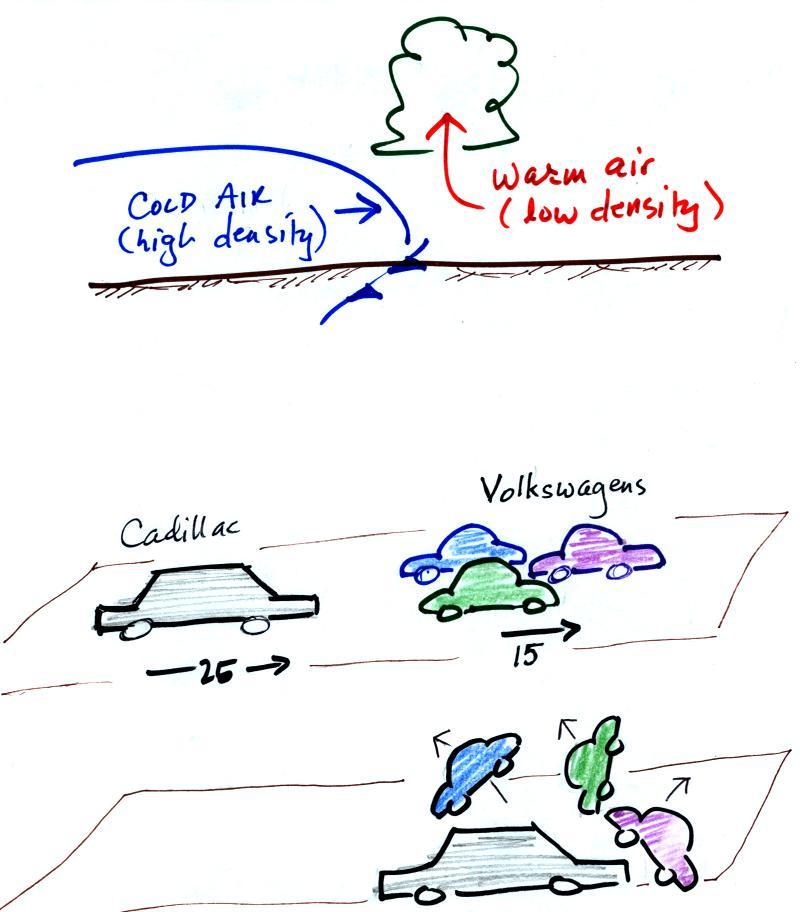
At the top of the figure, cold
dense air on the left is
advancing into
warmer lower density air
on the right. We are looking at the front edge of the cold air
mass, note the blunt rounded shape. The warm low density air is
lifted
out of the way
by the cold air. The warm air is rising.
The lower figure shows an analogous situation, a big heavy
Cadillac
plowing into a bunch of
Volkswagens. The VWs are thrown up into the air by the Cadillac.
Here's a crossectional view of a
warm front, the structure is a
little different.
In the case of a warm
front we are looking
at
the
back,
trailing edge of cold air (moving slowly to the right). Note the
ramp
like shape of the cold air mass. Warm air overtakes the cold
air. The warm air is still less dense than the cold air, it can't
wedge its way underneath the cold air. Rather the warm air
overruns the cold air. The
front can advance only as
fast as the cooler air moves away to the right.
The warm air rises again and
clouds form. Because the warm air rises more gradually, clouds
that form are generally spread out over a
larger area than with cold fronts.
In the automobile analogy, the VWs are catching a
Cadillac. What
happens
when they overtake the Cadillac?

The Volkswagens
aren't heavy
enough to lift the
Cadillac.
They run up and over the Cadillac.
Fronts are a second way of causing air to rise (winds spiraling
into surface centers of low pressure, convergence, was the 1st way)
Next
we
will spent some time learning about the weather conditions that
precede and
follow passage of warm and cold fronts.
A crossectional view of a cold front is shown below:
Here are some of the specific weather changes that you might expect to
observe before and after passage of a cold front. The figure in
the picture above is positioned ahead of an approaching cold
front. The person would experience relatively warm conditions,
winds would be blowing from the SW, and pressure would be
falling. These conditions are listed in the right most column in
the table below.
Weather
variable
|
Behind,
after the cold front has passed through
|
As the
front is passing through
|
Ahead,
before the arrival of the cold front
|
Temperature
|
cool, cold, colder*
|
|
warm
|
Dew Point
|
usually much drier*
|
|
may be moist (though that
is often
not the case here in the desert southwest)
|
Winds
|
northwest
|
gusty winds (dusty)
|
from the southwest
|
Clouds,
Weather
|
clearing
|
rain clouds, thunderstorms
in
narrow band along the front
(if the warm air mass is moist)
|
might see some high clouds
|
Pressure
|
rising
|
reaches a minimum
|
falling
|
* the coldest air might follow passage of a cold front by a day
or two. Nighttime temperatures often plummet in the cold dry air
behind a cold front.
A temperature drop is probably the most obvious change associated with
a cold front. Here in southern Arizona, gusty winds and a wind
shift are also often noticeable when a cold front passes.
The pressure changes that precede and follow a cold front are not
something we would observe or feel but are very useful when trying to
locate a front on a weather map.
In the next figure we started with
some weather data
plotted on a
surface map using the station model notation.
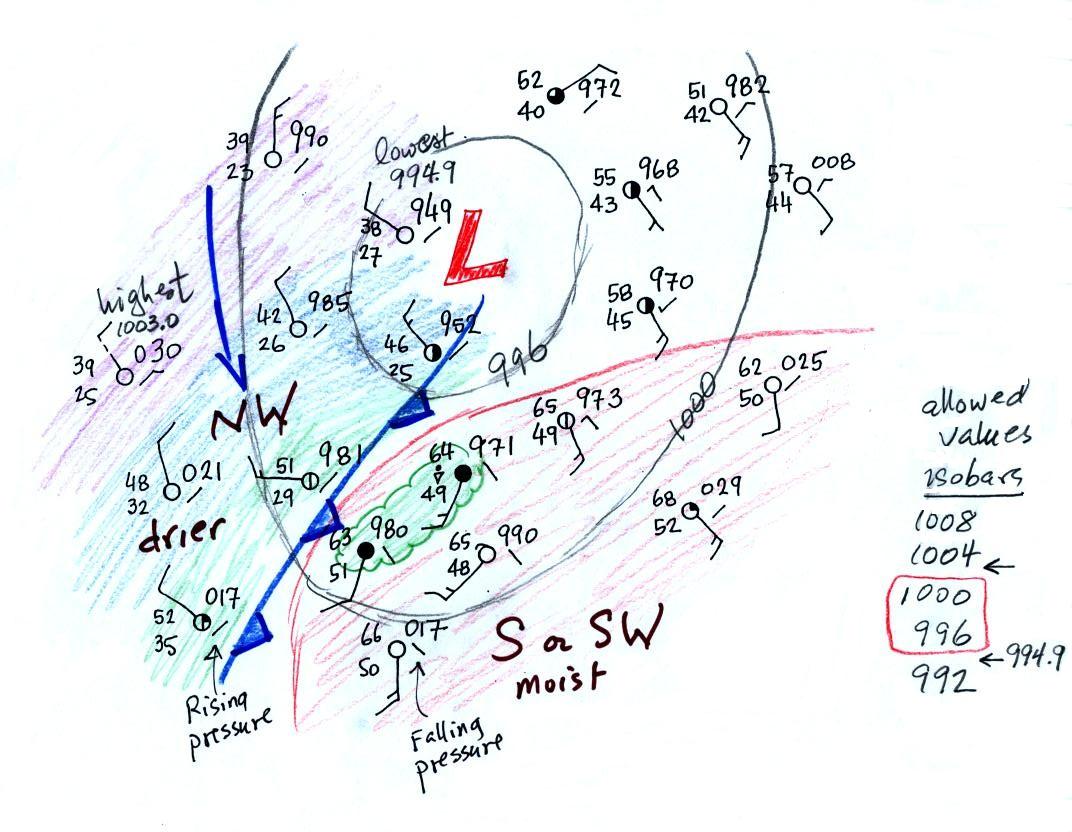
Before trying to locate a cold front, we needed to draw in a few
isobars and map out the pressure pattern. In some respects fronts
are like spokes on a wheel - they rotate counterclockwise around
centers of low pressure. It makes sense to first determine the
location of the low pressure center.
Isobars are drawn at 4 mb increments above and below a starting value
of 1000 mb. Some
of the allowed values are shown on the right side of the figure.
The highest pressure on the map is 1003.0 mb, the lowest is 994.9
mb. Thus we have drawn in 996 mb and 1000 mb isobars.
The next step was to try to locate the warm air mass in the
picture. Temperatures are in the 60s in the lower right portion
of the map; this area has been circled in red.
The cold front on the map seems to be properly postioned. The air
ahead of the front is warm, moist, has winds blowing from the S or SW,
and the pressure is falling. These are all things you would
expect to find ahead of a cold front.
Clouds and a rain shower were located right near the front which is
typically where they are found.
The air behind the front is colder, drier, winds are blowing from the
NW, and the pressure is falling. Note how the cold front is
positioned at the leading edge of the cold air mass, not necessarily in
front of the coldest air in the cold air mass.
Next we follow the same procedure with warm fronts.
Here's the crossectional view
Here are the typical weather conditions in advance of and following the
frontal
passage.
Weather
Variable
|
Behind,
after the front has passed through
|
As the
front is passing through
|
Ahead,
before the front arrives
|
Temperature
|
warmer
|
|
cool
|
Dew point
|
may be moister
|
|
drier
|
Winds
|
from S or SW
|
|
from E or SE
|
Clouds, Weather
|
clearing
|
|
wide variety of clouds well
ahead of the front,
may be a wide variety of types of precipitation also.
|
Pressure
|
rising
|
reaches a minimum
|
falling
|
And here is the surface map analysis:
Note the extensive cloud coverage and precipitation found ahead of the
warm front. There is a pretty good temperature and dew point
difference on opposite sides of the warm front and a clear shift in
wind directions. Pressure is falling ahead of the warm front and
rising behind.
There was also pretty clear evidence of a cold front on this map.
Finally, here is the surface map that we began this lecture
with. We were
trying to figure out what was causing the clouds in the NE portion of
the map and what was causing the rain shower along the Gulf
Coast. A
warm front and a cold front have been added to the isobaric analysis.
The warm front
is probably what is producing most of the widespread cloudiness and
precipitation in the NE portion of the map (rising air motions caused
by surface winds converging into the low pressure center are also
contributing). The cold front is producing the showers along the
Gulf Coast.
Processes that cause rising air motions are important.
Rising air expands and cools. If the air is moist and is cooled
enough, clouds can form.
Convergence is the first process that causes rising air motions.
As we've just seen, both warm and cold fronts cause air to rise.
Warm air is lifted by the cold dense air behind an advancing cold
front. Warm air overruns cool retreating air along a warm front.
Free convection, something we have already covered, is the 3rd
process.
Topographic or Orographic lifting
is the 4th way of causing air to
rise.
When moving air encounters a mountain it must pass over
it. You often find clouds and rain on the windward side of the
mountain where the air rises. Drier conditions, a rain shadow, is
found on the leeward side where the air is sinking (assuming that the
winds mostly blow in the same direction over the mountain).
Here is
the answer to the question found earlier in the notes concerning wind
directions and wind speeds
The winds are blowing from the NNW
at Points 1 and 3. The winds are blowing from the SSE at Point
2. The fastest winds (30 knots) are found at Point 2 because that
is where the isobars are closest together (strongest pressure
gradient). The slowest winds (10 knots) are at Point 3.
